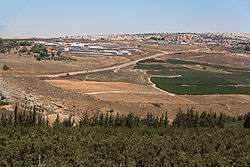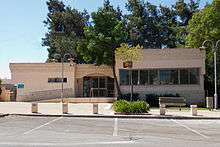Avivim
| Avivim | |
|---|---|
 | |
 Avivim | |
| Coordinates: 33°5′21.2″N 35°28′19.43″E / 33.089222°N 35.4720639°ECoordinates: 33°5′21.2″N 35°28′19.43″E / 33.089222°N 35.4720639°E | |
| District | Northern |
| Council | Merom HaGalil |
| Affiliation | Moshavim Movement |
| Population (2017)[1] | 489 |

Avivim (Hebrew: אֲבִיבִים), is a moshav in the far north of Israel, in the Upper Galilee. It is located less than one kilometre (3,000 feet) from the Blue Line with Lebanon, on lands of the Shiite village of Saliha, depopulated after a massacre carried out by Israeli forces.[2][3][4] In 2017 its population was 489.[1]
History
In 1920, Saliha was designated part of Lebanon under the auspices of the Franco-British Boundary Agreement. It was one of 24 villages transferred to British control in 1924 following the 1923 demarcation of the border between the British Mandate for Palestine and the French Mandate for Syria and the Lebanon.[5] It thus formed part of Palestine.
Under the 1947 United Nations Partition Plan for Palestine, Saliha was to be included in the proposed Arab state, while the boundary between it and the proposed Jewish state was to run north of the built-up area of the village. During the 1948 Arab–Israeli War, Saliha was the site of a massacre carried out by Israeli forces shortly before the village was completely depopulated. The built structures in the village, with the exception of an elementary school for boys, were also destroyed. Israeli forces blew up the village mosque, killing 60–94 people who were inside.[6]
Moshav Avivim was founded in 1958, abandoned, and then reestablished in 1963 by immigrants from North Africa, mostly Moroccan Jews.
Arab–Israeli conflict
The moshav's proximity to the Lebanese border has made it a target for violent attacks, most notably the Avivim school bus massacre. On May 8, 1970, militants of the pro-Syrian Baathist As-Sa'iqa organization fired two bazooka shells[7] at the community school bus, killing nine children and three adults, and injuring 19 others.[8] In October 1970, guerrillas in Lebanon fired mortars at Avivim, triggering an alert along the Lebanese border.[9]
Avivim also suffered during the 2006 Lebanon War, and was subject to at least one infiltration attempt by Hezbollah. The moshav also came under fire from Hezbollah forces in the nearby village of Maroun al-Ras, across the border in Lebanon.[10]
References
- 1 2 "List of localities, in Alphabetical order" (PDF). Israel Central Bureau of Statistics. Retrieved August 26, 2018.
- ↑ "The seven lost villages", Danny Rubenstein, Haaretz, 4 August 2006, at Independent Medi Review Analysis website. Original article at www.haaretz.com/hasen/spages/746274.html.
- ↑ Morris, Benny. (2004) The Birth of the Palestinian Refugee Problem Revisited. Cambridge University Press. ISBN 0-521-00967-7
- ↑ The Seven Villages, Origins and Implications
- ↑ Asher Kaufman. Seven Shii Villages as a Case Study of Boundaries, Identifies and Conflict "Between Palestine and Lebanon: Seven Shi'i Villages as a Case Study of Boundaries, Identities, and Conflict" Check
|url=value (help). Middle East Journal. 60 (4): 685–706. - ↑ Benny Morris (2004). The Birth of the Palestinian Refugee Problem Revisited. Cambridge University Press. p. 481.
- ↑ Moshav Avivim still stands determined during tensions
- ↑ Israeli-Palestinian Conflict: from Balfour Promise to Bush Declaration, Gabriel G. Tabarani
- ↑ Avivim Settlement under Mortar Fire From Terrorists in Lebanon
- ↑ Moshav Avivim still stands determined during tensions